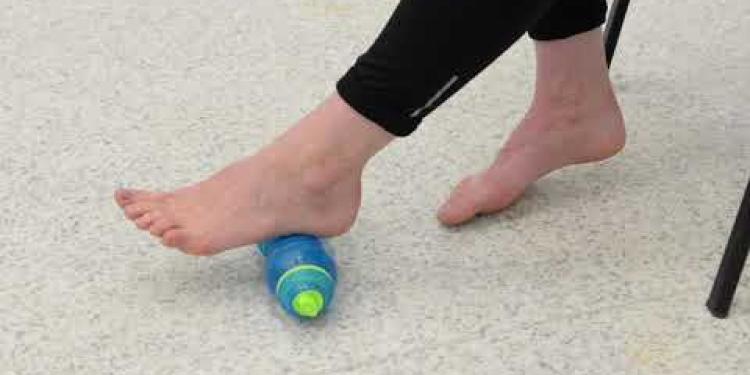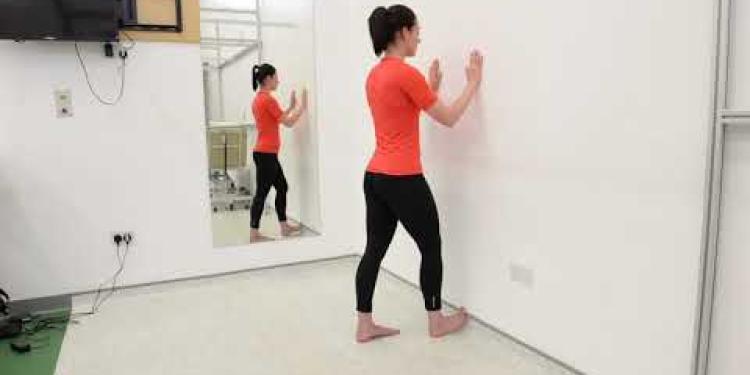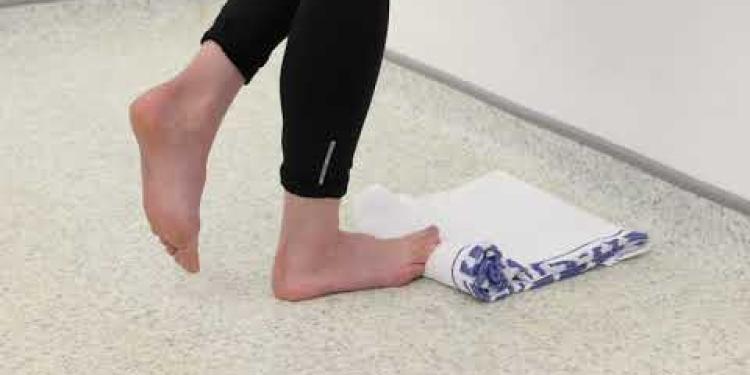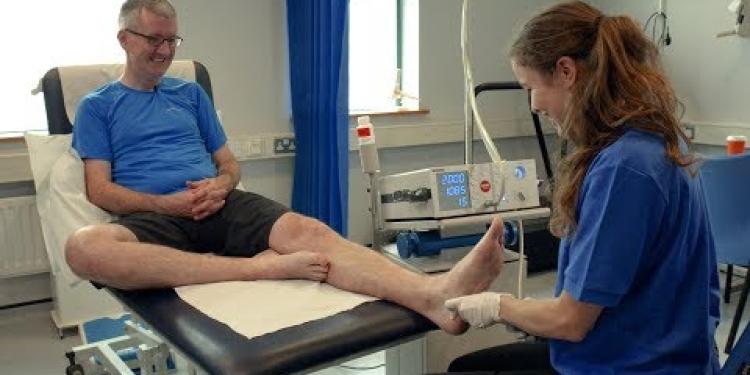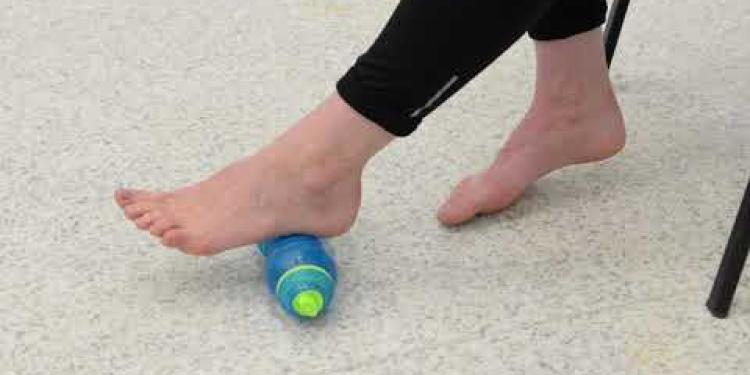Important Information On Using This Service
- Ergsy carefully checks the information in the videos we provide here.
- Videos shown by YouTube after a video has completed have NOT been reviewed by ERGSY.
- To view, click the arrow in the center of the video.
Using Subtitles and Closed Captions
- Most of the videos you find here will have subtitles and/or closed captions available.
- You may need to turn these on and choose your preferred language.
Turn Captions On or Off
- Go to the video you'd like to watch.
- If closed captions (CC) are available, settings will be visible on the bottom right of the video player.
- To turn on captions, click settings.
- To turn off captions, click settings again.
Find A Professional
More Videos of Interestdiagnosis
Plantar Fascia Wall Stretch
Introduction
The Plantar Fascia Wall Stretch is a highly effective exercise aimed at alleviating pain associated with plantar fasciitis. This condition, common among both athletes and non-athletes in the United Kingdom, involves inflammation of the plantar fascia—the thick band of tissue running along the bottom of the foot, connecting the heel bone to the toes.
Why It’s Important
Plantar fasciitis can lead to debilitating foot pain, making everyday activities like walking or standing quite uncomfortable. Regularly performing the Plantar Fascia Wall Stretch can help in the recovery process by improving the flexibility of the plantar fascia, thereby reducing pain and preventing further injury. It’s a simple yet effective way to maintain foot health, especially for those who spend long hours on their feet.
How to Perform the Stretch
- Stand facing a wall, about an arm's length away.
- Place both palms flat against the wall for support.
- Step your affected foot back, keeping the heel flat on the ground and toes pointing straight ahead.
- Adjust the distance of your back foot to ensure a gentle stretch along the arch of your foot.
- Bend the front knee slightly, while keeping the back leg straight, to deepen the stretch.
- Hold the position for 30 seconds, feeling a mild stretch without discomfort.
- Release the stretch and switch legs, repeating the process 2-3 times for each foot.
Precautions
While performing the stretch, make sure to perform movements slowly and deliberately to avoid any sudden stress on the plantar fascia. If you feel any sharp pain, stop the activity immediately and consult a healthcare professional. Pregnant women or individuals with existing foot conditions should seek medical advice before beginning this routine.
Conclusion
The Plantar Fascia Wall Stretch is a simple yet effective exercise that can significantly aid in reducing pain associated with plantar fasciitis. Regular incorporation of this stretch into your daily routine can enhance foot health, particularly for individuals frequently on their feet. Give this stretch a try and take the first step towards pain-free feet.
Frequently Asked Questions
What is a Plantar Fascia Wall Stretch?
A Plantar Fascia Wall Stretch is a specific exercise designed to stretch the plantar fascia, which is the ligament that runs along the bottom of your foot from your heel to your toes.
How do you perform a Plantar Fascia Wall Stretch?
To perform a Plantar Fascia Wall Stretch, stand facing a wall with your toes pointing towards it. Place your affected foot against the wall with the heel on the ground and toes upwards. Slowly lean in towards the wall, keeping your knee straight until you feel a stretch along the bottom of your foot.
What are the benefits of doing a Plantar Fascia Wall Stretch?
The benefits include reduced pain in the plantar fascia, increased flexibility, and improved foot mobility. It can also help in preventing conditions like plantar fasciitis and heel spurs.
How often should I do the Plantar Fascia Wall Stretch?
It's generally recommended to do the stretch at least 3 times a day. Consistency is key for seeing improvement.
Can anyone do the Plantar Fascia Wall Stretch?
Most people can safely perform this stretch. However, if you have an existing foot injury or severe pain, it's best to consult with a healthcare professional before starting any new exercise.
Can this stretch help with plantar fasciitis?
Yes, the Plantar Fascia Wall Stretch can be particularly helpful for alleviating the symptoms of plantar fasciitis by gently stretching and strengthening the affected area.
Do I need any equipment to do a Plantar Fascia Wall Stretch?
No, you don't need any special equipment. All you need is a wall to perform the stretch.
How long should I hold the stretch?
Hold the stretch for about 20-30 seconds. Repeat it 2 to 3 times for each foot.
Is the Plantar Fascia Wall Stretch safe for pregnant women?
Generally, it is safe, but pregnant women should consult with their healthcare provider before starting any new exercise routines.
What are the signs that I should stop doing the stretch?
If you experience sharp or shooting pain, excessive discomfort, or if your symptoms worsen, stop the stretch and consult a healthcare professional.
Can children do the Plantar Fascia Wall Stretch?
Yes, children can perform this stretch, but it should be done under adult supervision to ensure it is done correctly and safely.
Will this stretch help with heel pain?
Yes, stretching the plantar fascia can reduce heel pain, especially if the pain is due to plantar fasciitis or similar conditions.
What kind of shoes should I wear while doing the stretch?
You can do this stretch barefoot or wearing supportive athletic shoes.
Should I warm up before doing the Plantar Fascia Wall Stretch?
It's a good idea to do a light warm-up like walking or gentle foot exercises to prepare your muscles and ligaments for stretching.
Can I do this stretch if I have flat feet?
Yes, individuals with flat feet can benefit from this stretch as it helps in maintaining foot flexibility and reducing strain on the plantar fascia.
Useful Links
Useful links from: Heel pain | NHS
- Heel Pain - NHS Comprehensive guide on heel pain including symptoms, causes, diagnosis, and treatment options provided by the NHS.
- Plantar Fasciitis - NHS Detailed information on plantar fasciitis, a common cause of heel pain. Includes symptoms, treatments, and self-care tips from the NHS.
- Versus Arthritis - Heel Pain An in-depth look at heel pain, its causes, and treatment options from the UK-based charity Versus Arthritis.
- Foot Health - NHS General information on foot problems, including heel pain, their causes, and how to prevent or treat them. Provided by the NHS.
Useful links from: Plantar fasciitis
- NHS - Plantar Fasciitis This page from the NHS provides an overview of plantar fasciitis including symptoms, causes, diagnosis, and treatment options.
- Versus Arthritis - Plantar Fasciitis Versus Arthritis offers detailed information on plantar fasciitis, including its symptoms, causes, and ways to manage the condition.
- Chartered Society of Physiotherapy - Plantar Fasciitis This resource from the Chartered Society of Physiotherapy provides evidence-based advice on managing plantar fasciitis at home and when to seek professional help.
- Health and Care Professions Council (HCPC) - Podiatry The HCPC provides insights on various podiatry conditions, including plantar fasciitis, and ways to access professional podiatric care in the UK.
Useful links from: Plantar Fascia Loading Exercise (High Load Exercise)
- NHS - Treatment for Plantar Fasciitis The NHS page on treatment for heel pain, including plantar fasciitis, provides a comprehensive overview of various treatment options including high-load exercises.
- Versus Arthritis - Plantar Fasciitis Versus Arthritis provides detailed information on plantar fasciitis, its causes, symptoms, and various treatment options including exercise recommendations.
- NHS Inform - Plantar Fasciitis NHS Inform offers information on the symptoms, causes, and treatments for plantar fasciitis. It includes advice on exercises that can help manage pain and support recovery.
- PhysioNet - Plantar Fasciitis Exercise Program PhysioNet provides an exercise program specifically designed for plantar fasciitis, including high-load exercises to help manage and alleviate symptoms.
More Videos of Interestdiagnosis
Have you found an error, or do you have a link or some information you would like to share? Please let us know using the form below.
- Ergsy carfully checks the information in the videos we provide here.
- Videos shown by Youtube after a video has completed, have NOT been reviewed by ERGSY.
- To view, click the arrow in centre of video.
- Most of the videos you find here will have subtitles and/or closed captions available.
- You may need to turn these on, and choose your preferred language.
- Go to the video you'd like to watch.
- If closed captions (CC) are available, settings will be visible on the bottom right of the video player.
- To turn on Captions, click settings .
- To turn off Captions, click settings again.
